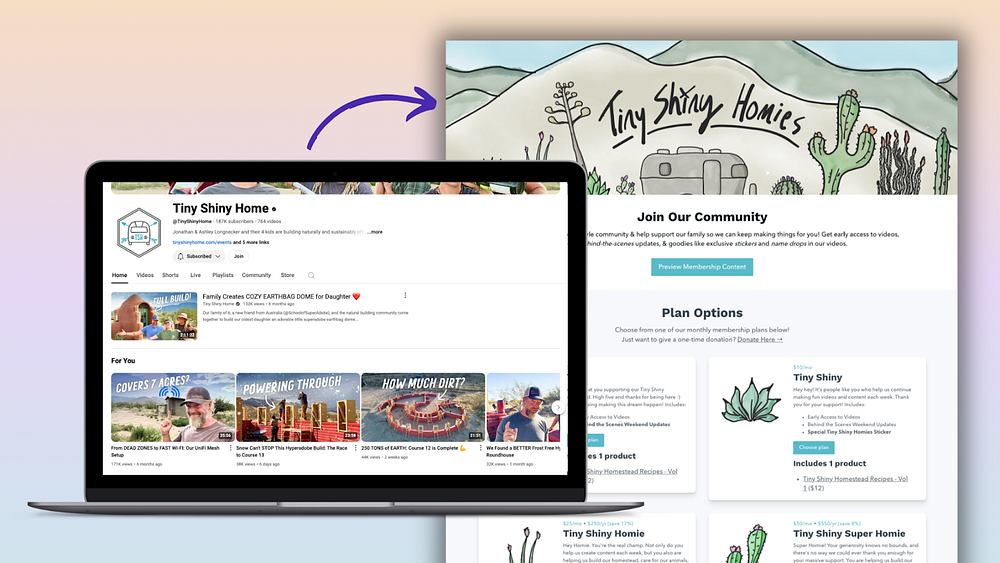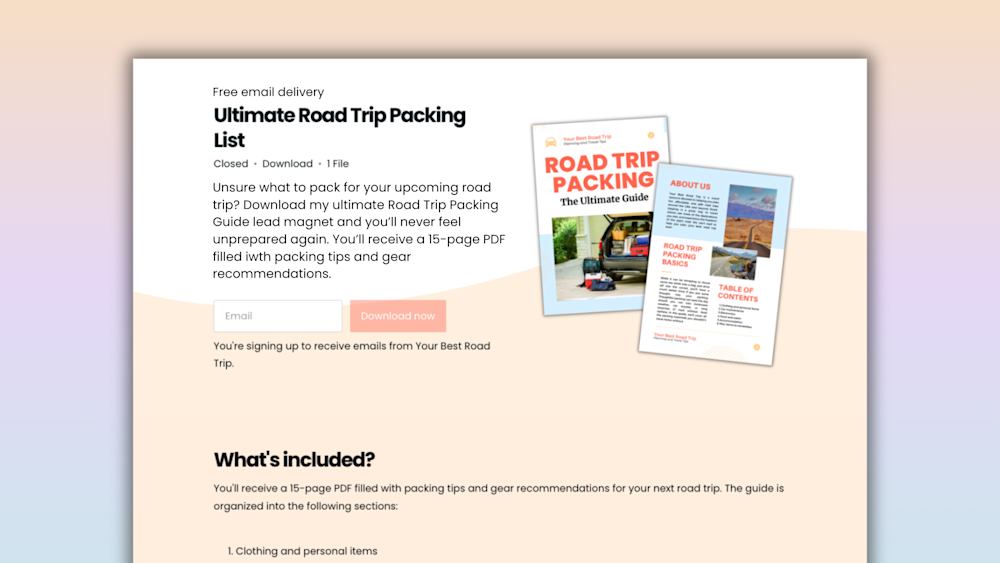As a creator or solopreneur, you are your brand.
That’s especially true if you run an education, coaching, or lifestyle business. Your personality, expertise, and unique outlook are all part of what makes you stand out from your competition.
That’s what makes your About page one of the most important pages on your site. It’s a space for you to introduce yourself, tell your story, and show prospective clients and customers what you’re all about.
Writing about yourself can feel intimidating or awkward, especially if you struggle with imposter syndrome and don’t consider yourself an expert. But you don’t need to be a professional copywriter or blogger to write an About page that captures your audience’s attention.
Here are four tips for creating an About page that makes you and your business shine, including real-world About page examples to get you inspired.
Tip #1: Tell your story
Instead of writing an About page that reads like a resume, tell your story. It’s far more unique and authentic than a list of accomplishments — and 86% of consumers cite authenticity as a key factor when deciding what brands they like and support.
But if you’re not jumping for joy at the prospect of writing about yourself, you’re not alone.
Freelance writer and coach Kaleigh Moore explains:
“Writing About page copy is something a lot of people struggle with, because:
- It feels gross and weird to write about yourself.
- It’s hard to know what’s too much (or too little) information.
- You don’t want to creep people out or scare people off by over-sharing.”
Your story doesn’t have to be a deep dive into the darkest recesses of your personal life.
Instead, explain how you got to where you are today: (Virtually) standing in front of the reader, introducing yourself and your business and inviting them to learn more. What steps did you take to get here?
For example, Kaleigh’s About page describes the services she offers and her background as a writer and ecommerce expert:

If readers want to learn more about Kaleigh, they can read a longer version of her story at the “Read more” link. If they don’t, they got what they came for in the first few paragraphs.
Your About page is also a great place to share your mission statement, a.k.a. the “why” behind your business. What drives you to get up each morning and do what you do?
In the words of renowned author and motivational speaker Simon Sinek, the “why” is “a purpose, cause, or belief. It’s the very reason your organization exists”.
Sinek places the “why” at the center of any successful business — inside the “how” and “what” — and calls this concept the Golden Circle.

To identify your “why,” ask yourself:
-
What motivated you to start your business?
-
What excites you about solving your audience’s problem?
Once you figure out your “why,” everything else falls into place. And when you share your “why” with the world, it’ll resonate with the right audience.
Tip #2: Talk to your audience
Your About Me page is about you, but that doesn’t mean it’s all about you.
It’s about building a connection with your audience so they trust you and want to get to know you, buy from you, or take your course. When customers feel like they know and trust you, it builds loyalty and creates a better customer experience.

-
56% of customers stay loyal to brands that “get them”.
-
89% of customers stay loyal to brands who share their values.
With that in mind, make your About page more of a conversation than a monologue. This technique can also make it feel less weird to talk about yourself.
Write about yourself in the context of how you can help your target audience. Show them that you share their values and speak their language. (If you’re not sure what they value, it’s time to do some customer research.)
For example, public speaking coach Maria Marquis uses her About page to offer her audience the support they need to meet their goals.

Maria knows that her audience is looking for a partner and an ally and introduces herself as that person. She also links to her LinkedIn profile so readers can learn more about her.
Similarly, business strategist Minessa Konecky draws from her experience building a “hustle-free” lifestyle to introduce herself and her philosophy to website visitors:

Minessa’s target audience is entrepreneurs looking to grow their businesses without getting overwhelmed. From her copy, it’s clear that she understands the struggle that her audience faces and is well-equipped to help them overcome it.
Maria and Minessa also connect with their audiences by writing in a conversational tone. Writing like you (and your customers) speak makes them more likely to connect with you.
Here’s why: It’s human nature to trust what’s similar to us more readily than things that are different from us. When your copywriting reflects your customers’ language, it’s easier to relate to and trust than if you use jargon.
Along those same lines, most About pages are written in the first person, with “I” statements, rather than in the third person. The third person sometimes feels too formal and reads more like a press release than an invitation to build a relationship.
What does all this look like in action? Check out the closing lines of entrepreneur, writer, and philanthropist Marie Forleo’s About page:

Marie writes in the first person and comes across as though she’s writing to a friend rather than a potential customer or total internet stranger. And while it may feel too personal to some, the tone fits her brand perfectly.
Using your customers’ words to tell your story can also go one step further with the inclusion of social proof.
Tip #3: Include customer testimonials
When you add customer testimonials and reviews to your About page, your customers help you tell your story. Sharing their feedback and results enables you to be taken seriously and showcase what sets you apart from the competition.
Here’s why social proof is such a powerful tool:
-
Only a third of people say they trust the brands they buy from…
-
… but 72% of consumers say positive reviews and testimonials make them trust a business more.
-
Across industries, potential customers who look at user-generated content like reviews and testimonials convert at a 161% higher rate than people who don’t.
Customer testimonials are particularly important if you’re a coach or consultant. In those roles, your brand is all about how you interact with and help your clients.
Online startup coach and entrepreneur Shalena D.I.V.A. shares client testimonials on her About page:

Testimonials like Sherica’s highlight the benefits of working with Shalena, from writing a best-seller to launching a product line.
Basically, when you showcase your clients’ results and feedback, you show potential customers, “This could be you”.
To learn more about using customer testimonials on your About page and beyond, check out our guide on how to ask for testimonials, including templates for requesting testimonials.
Now that we’ve covered the verbal must-haves for your About page, let’s move on to the visual.
Tip #4: Add visuals and a CTA
Your About page is an opportunity for your brand to shine, and visuals are a big part of entrepreneur branding.
First and foremost, consider adding a high-quality headshot, like this one on John D. Saunders’ website:

“People buy from people” is a classic sales mantra for a reason. Adding human photos, especially those which include facial characteristics, increases trust, improves a visitor’s first impression of a business, and boosts conversions.
If you don’t want to show your face for privacy reasons, you can still add visual elements that reflect your personality, like a photo of your pet or a favorite vacation spot.
You can even add an infographic that tells your brand’s story, like the ones on Preting Consulting’s About Us page. Preting uses infographics to showcase “its capabilities, clients, certifications and other things about the company”.

If your products include video content or face-to-face coaching calls, add a video introducing yourself and your business. Just keep it short and sweet: 68% of viewers will watch a video to the end if it’s less than 60 seconds.
On the user experience (UX) side of things, make sure you use headers to make your About page easy to scan so people can find the info they’re looking for.
Another critical element of your About page is a clear call-to-action.
Your About page needs to inspire action, whether that’s signing up for your email list, contacting you, or making a purchase. Make it easy for site visitors to take that next step by including a call-to-action (CTA).
A CTA tells your visitor what they should do next, like download an ebook or join your free trial. For example, Marie Forleo invites readers to join her email list:

Kaleigh Moore asks readers to contact her:

And business mindset coach Becky Mollenkamp offers a free masterclass as a lead magnet:

Whatever CTA you choose, make sure there’s only one. Thanks to the phenomenon of “choice paralysis,” giving people too many choices makes them less likely to choose anything at all. Stick to one high-priority CTA, and your visitors are far more likely to take action.
To learn more about crafting a great CTA, check out our guide to landing page best practices.
With all these tips and tricks under your belt, you’re ready to create an awesome About page. Keep reading to learn how Podia makes it easy to do just that.
How to add an About page to your Podia site
If you sell digital products with Podia, it’s easy to add an About page or section to your site — no templates, WordPress theme, or web design expertise required. Here’s how.
(Don’t have a Podia account? Sign up for a free 30-day trial to get in on the action.)
First, go to the Podia Editor. Click into the dropdown menu on the upper left corner and select “New Page”.

Click the plus sign to add a section, then select “Bio” as your section type. When you create a Bio, you can add it to multiple pages on your Podia site without rewriting the content for each page. Just add a Bio section to any page where you want your bio to show up.


Add a photo, headline, and text to your About page. You can also add links to your social media profiles.


Under the “Design” tab, you can customize the layout, colors, and background image for your About page.

When you’re happy with your About page, click “Publish” in the upper right corner.

And just like that, your About page is live on your site. It’s that easy.
Write an About page that captures your spirit
At the end of the day, your About page is all about connecting and building a relationship with your audience.
To recap, follow these four tips for an About page that really shines:
-
Tell your story. Your background gives you a unique perspective and purpose — share that with your readers.
-
Make it a conversation, not a monologue. Show your audience that you understand them and can help them reach their goals.
-
Use customer testimonials to gain credibility and help potential customers see the results they can achieve.
-
Give your page personality with photos and videos, then add a call-to-action to make it easy for visitors to take the next step.
Now go out there and create an About page that’s as unique and awesome as you are.



